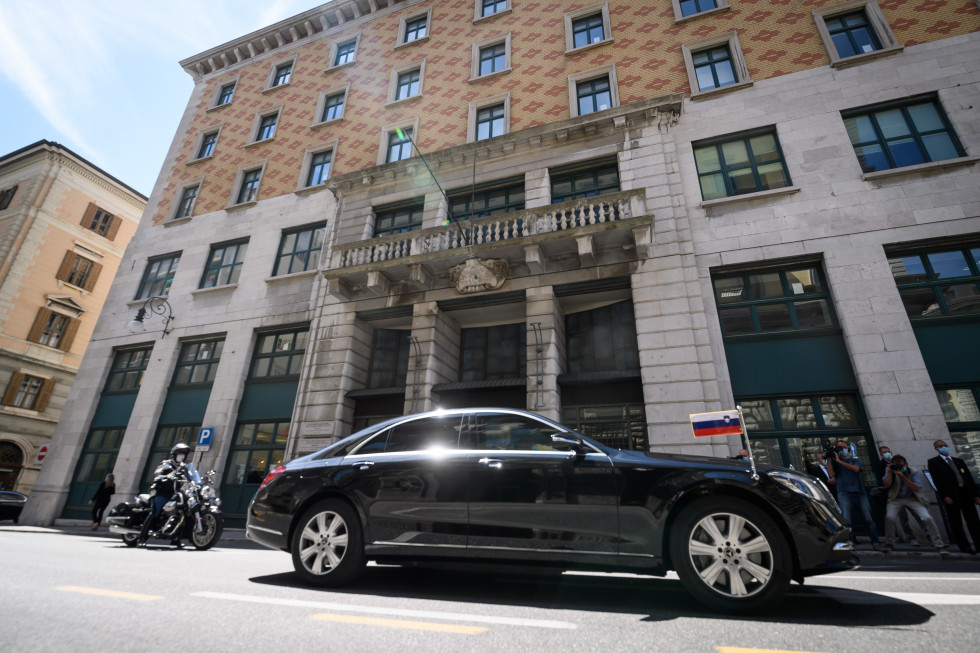Handover of the Trieste National Hall as a sign of coexistence and friendship between Slovenians and Italians
- Ministry of Foreign Affairs

The National Hall in Trieste | Author STA
The line-up of ministers from both countries at today’s ceremony included the Slovenian Minister of Foreign Affairs, Dr Anže Logar, and the Italian Minister of Foreign Affairs and International Cooperation, Luigi Di Maio. Their third meeting in the past month and a half testifies to the close and friendly ties between the neighbouring countries that, by reaching an agreement on the handover of the National Hall, demonstrated strong mutual respect and understanding. The restitution of the National Hall has featured high on the agenda of bilateral discussions in recent years, especially in the run-up to the centenary of the arson attack and during the preparations for the ceremony to mark this historic moment. For the past decade, Slovenian diplomacy has made every effort at various levels to pave the way and remove any obstacle for this step to finally happen. In fact, the return of the National Hall could not have happened without the cooperation and the disposition of the Italian authorities.
Since its inauguration in 1904, the National Hall has been regarded as a national, political, cultural and economic symbol for Slovenians living in Trieste, and its handover can largely be credited to the Slovenian national community in Italy. With the adoption of the 2001 act on the protection of the Slovenian minority in Italy, the restitution of seized property to the Slovenian community was mentioned for the first time in the Italian legislation. In the past few decades, the building has been occupied by the University of Trieste, which in 2004, handed over a ground floor room to the Slovenian National and Study Library. It was first used as a Slovenian information centre, and since 2014, as home to the library’s section for young readers. In spring 2019, the University assigned additional ground floor rooms to the Slovenian minority.
This year also marks 20 years since the publication of the joint report of the Slovenian-Italian Historical and Cultural Commission in which experts agreed on the tumultuous past of bilateral relations and warned of the dangers of such historical differences becoming issues of the present or burdens of the future. The report also addressed the period 100 years ago, of which the historians of both countries wrote: “The arson attack on the National Hall, the headquarters of Slovenian organisations in Trieste, in July 1920, as an apparent counter-attack for the Split riots which claimed the lives of many Italians and Slavs, was a sombre presage of the violence to come.” Alas, even after all these years, the findings of the joint Commission have not been accepted in Italy. Since the publication of the report, senior officials of the Republic of Slovenia have on multiple occasions called on representatives of Italy to adopt the report and make it publicly available to prevent any misrepresentation of the established historical truths, especially for younger generations. The Ministry of Foreign Affairs takes this opportunity to call on the Italian side to adopt the report and apply the findings thereof in the historical recounts of the period in question.
The restitution of the symbol of Slovenian identity in Trieste is charged with concrete and abstract meanings: it is an homage to the 25 years of suffering of Slovenians in the Primorska region under Italian nationalists and fascists; the agreement on the restitution of the building is also an act of reconciliation and an attempt to seek a common understanding of the tragic episodes of the 20th century and deepen mutual respect. Finally, the act of handover is also a sign of good neighbourly relations and coexistence among nations in the spirit of common European values. All this pertains to the fundamental tasks before Slovenian diplomacy in relation to neighbouring countries and nations.
“I wish for the National Hall to become a house of dialogue, a house of friendship and a house of co-existence among nations contributing to the multicultural and multilingual future of Trieste. May the centenary of the arson attack on the National Hall also symbolise the renaissance of the city and Slovenian-Italian relations in our common European house,” wrote Minister Logar on this historic occasion. Today, we have definitely turned a new page in the common, even more integrated future of our two nations, not only in Trieste and along the border, but also throughout the European Union of peace, respect of the differences and cooperation.

